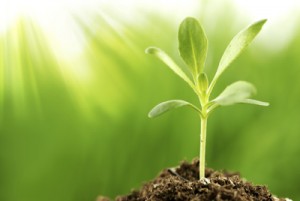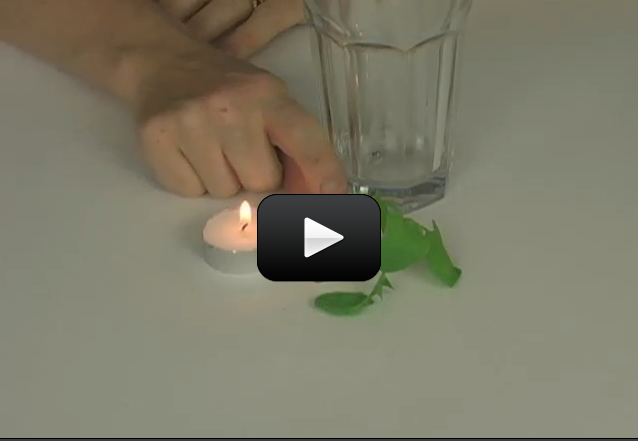 Photosynthesis is a process where light energy is changed into chemical energy. As we said in the last section, this process happens in the chloroplast of plant cells. Photosynthesis is one of the most important things that happen in cells.
Photosynthesis is a process where light energy is changed into chemical energy. As we said in the last section, this process happens in the chloroplast of plant cells. Photosynthesis is one of the most important things that happen in cells.
In fact, photosynthesis is considered one of the most important processes for all life on Earth. It makes sense that photosynthesis is really important to plants, since it gives them energy, but why is it so important to animals? Let’s learn a little more about photosynthesis and see if we can answer that question.
There are many steps to photosynthesis, but if we wanted to sum it up in one equation, it would be carbon dioxide (CO2) + water (H2O) makes glucose (C6H12O6) and oxygen (O2). These words can be written like this:
[am4show have=’p8;p9;p26;p53;p87;’ guest_error=’Guest error message’ user_error=’User error message’ ]
6CO2 + 6H2O + Light Energy –> C6H12O6 + 6O2
Carbon dioxide, water, and energy combine to form glucose and oxygen.
We learned in the last section that glucose is a kind of sugar. This sugar is important for energy, so the plant stores all the glucose it creates. However, the plant releases the oxygen it creates.
Now we can see two reasons why photosynthesis is so important not just to plants, but to animals too. First, all animals need oxygen to live. Photosynthesis produces oxygen, so without this process, animals could not survive. Also, don’t forget that since animals can’t make their own food, they have to eat plants, or eat other animals that have eaten plants. So without plants, animals would quickly run out of food.
This experiment will demonstrate that carbon dioxide is necessary in photosynthesis.
Materials:
- candle
- lighter with adult help
- large glass jar
- stopwatch
- leafy plant (weeds work also)
Optional: sodium hydroxide and iodine
Download Student Worksheet & Exercises
1.Light your candle. invert the glass over it and time how long it takes the candle to use up all the oxygen and extinguish itself. Write this number down in your journal.
2. Find a young plant or bush, preferably with a lot of growth and leaves. Place your candle next to the plant (don’t burn your plant!) and invert the jar over it again. Use your stopwatch to time how long the candle stays lit. Write this number down in your journal.
3. Which one do you expect to take longer? What actually happened?
OPTIONAL BUT DANGEROUS…
Place the caustic soda on a disposable plate. Don’t get this on your hands or eyes – it’s very corrosive. Handle this chemical ONLY with gloves and keep away from small children and pets like dogs and cats.
Place the caustic soda next to the plant and cover with the glass. Leave this setup undisturbed for a few hours. When you’re done, take a leaf from the plant and do an iodine test on it to find out if there is starch present. Simply place a drop of iodine on the leaf. Iodine changes to dark blue when starch is present.
Exercises
- Describe the process of photosynthesis in words.
- Write the chemical equation for photosynthesis.
- What is glucose?
- Why is glucose important for plants?
- Why are plants necessary for animals?
- Does the result of the experiment depend on how large the plant is? Why or why not?
[/am4show]


Great work and an interesting hypothesis! Plants definitely do release carbon dioxide during cellular respiration – mostly at night, but it can happen during the day as well. Please let us know how your further testing goes.
We also performed this experiment. We used a reasonable sized Thyme bush, large jar and a tea candle. We performed this multiple times and ensured a seal using Plasticine. On average the the candle stayed lit longer without the plant for about 10 sec . We Hypothesis that because we performed this experiment indoors, on a cloudy day in an area that was not well lit that in stead of releasing O2 the plant released CO2 instead. Because it was a Thyme plant with small leaves, the difference in the results were not significant. We will test our Hypothesis both indoors and outdoors, using the same and different plants and compare results.
My daughter gained 6 seconds from adding a weed to the jar with her candle. We did not have a tealight candle available, so she had used a “birthday” candle. I don’t know if the candle type actually makes a difference. She is ready to do the experiment a few more times adjusting the variables to determine what works best.
The water pressure increases with ocean depth – you can learn more about how from the NOAA’s website here: http://oceanservice.noaa.gov/facts/pressure.html And yes, scientists can simulate this pressure using instruments that push more fluid into a vessel so the organisms inside the vessel can’t tell the difference from being on the ocean floor or at sea level in a pressurized container. Don’t forget that it’s also very cold at the bottom of the ocean, and there’s no air, and also at high pressures, chemical reactions work differently than they do at normal atmospheric pressures (on the surface).
Since the pressure is so high on the ocean floor, and exactly how high depends on how deep the floor is, you’d need a laboratory with pressurized containers (vessels) to simulate those conditions (cold, no air, high pressure…). However, you could design an experiment that changes the temperature (which also changes the chemical reactions) of plants, for example.
Hi,
I have a a couple of questions that aren’t entirely in this subject but i thought this was the best place to put them.
First of all, is it possible to create water pressure close to that at the bottom of the ocean?
Second, Are there any plants that can survive high water pressure and third,how high water pressure can I create at home? Can you suggest an experiment I could do about the impact of water pressure on life.
Thanks, Opal
All four Leggott kids had fun with this one (ages 12, 10, 7, and 5)! We did create a closed system by inverting the jar into a pan of water which the candle was setting in. We used a gallon jar and we repeated the entire progression of steps twice. With nothing in the jar the candle extinguished in 1.13 min. and 1.01 min the second time. With a small piece of kochia plant it extinguished in 55 seconds and 44 seconds on the second round. With a large plant of kochia (filling 1/4 of the jar) it took 53 seconds and 46 seconds. With a sunflower leaf (large) it took 45 seconds. It seems the leaves displace more oxygen than they can replace in less than a minute. We did observe a cool effect of the vacuum pulling water up into the jar!
When you say “inconsistent’, what kind of results were you getting? It’s pretty typical for an experiment not to go the way you had originally planned. Time to take out your “observational skills” and see if you can figure out what happened! Let me know how I can help.
Hi Aurora!
I was doing this experiment…and the candle wasn’t giving consistent results (=_=)
Should I do this experiment at night? because plants give out more oxygen at night.
Thanks~
-Dayini 🙂
Science is like this sometimes… giving us results we don’t quite expect! 🙂 And yes, it’s possible that if you didn’t use a large enough container or plant that it’s not generating enough oxygen to keep the flame going. Plant leaves typically produce about 5 milliliters of oxygen per hour, which is a lot less than a voracious votive candle consumes. Plants with more leaves generate more oxygen than plants with fewer leaves, so lots of large leaves produce more oxygen than smaller, sparser ones. The best producers out there are the Heart-Leaf Philodendron (it has evergreen vines, large leaves, and grows indoors) and the Peace Lily (has long, oval foliage and is easy to care for). The Bamboo Palm (or ladyfinger palm) is also an excellent indoor air cleaner and generator of fresh oxygen.
You might try bagging an entire shrub and using a tiny birthday candle to see if you can get the closes system to be stable for a couple of minutes.
we did not have the expected result either.
My son is learning about experiment variables. He said that with the volume of the plant and the pot took place, the amount of the oxygen at the beginning for the candle are not equal. So we can not be sure if the plant will provide enough oxygen to replace that amount it took place fast enough to keep the candle burn longer. Is it right ?
Remember that when we do experiments, we should never conclude that our experiment is unsuccessful just because we got a result that was different than our expectation. This just means we get to keep exploring. In your case, it seems the leaf was not large enough to produce enough oxygen to make an impact. So now your challenge is to find a plant that is large enough to produce that amount of oxygen. This means your going to need a REALLY big plant and a REALLY big space to avoid the problem you mentioned of forcing out oxygen. How big a plant and space do you need? That’s what the experimenting is all about. As you’re looking for that big plant, another thing to keep in mind is that this is a closed system. Basically, that means that once the cup goes over the candle and creates a seal, the candle, plant, and oxygen no longer interact with anything around them. This is necessary for the experiment (otherwise the candle could just get oxygen from the surrounding air) but it also makes things less stable, which may also play a role in the problems you’re experiencing. Keep trying… that’s what science is all about!
Has anyone been able to make this work – make the candle stay lit longer with the plant inside? We had the opposite effect – when we added a palm leaf (from an indoor plant) the candle actually extinguished sooner. We’re guessing we displaced oxygen by stuffing the palm leaf in the glass so there was less available for the candle. My daughter is wondering if having the palm leaf in the jar for a minute or two after running the experiment, then removing the palm and doing the experiment with the jar empty, would have allowed the plant to make more oxygen which would have been in the jar for the next round.